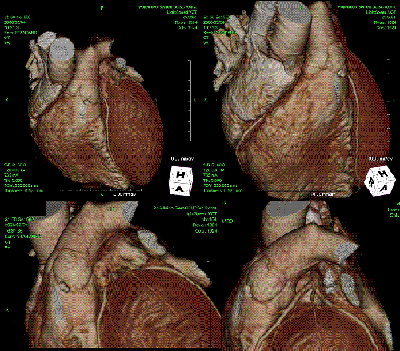Cardiac CT spots athletes at risk for sudden death
Multislice CT angiography can save lives by identifying occult congenital cardiac anomalies and disease that could lead to sudden cardiac death among competitive athletes.
Multislice CT angiography can save lives by identifying occult congenital cardiac anomalies and disease that could lead to sudden cardiac death among competitive athletes.
Fans may remember the tragic death of college basketball star Hank Gathers in March 1990. The presumed first choice in the impending National Basketball Association draft choice staggered, collapsed, and died in a few seconds during a nationally televised intercollegiate game. The incident left physicians to consider how his death could have been prevented.
A study from the Catholic University Gemelli Hospital in Rome reflects a continuation of those medical inquiries almost two decades later. Dr. Gianocarlo Savino and colleagues used 64-slice cardiac CT to diagnose suspected congenital cardiac abnormalities in 60 athletes. The subjects' average age was 28.9 years. All were involved in soccer, basketball, tennis, or other highly aerobic sports. Their clinical signs include ECG anomalies and abnormal transthoracic echocardiography (TTE). Savino presented the group's finding at the 2008 RSNA meeting.
Savino noted the correlation between physical exercise and sudden cardiac death is well established. The importance of anomalous coronary arteries in these incidences was revealed during the retrospective review of 6.3 million military records, he said.
"When these anomalies are suspected, the preferred diagnostic study should be the systematic exclusion of these anomalies," he said. "We know that multidetector CT emerged as the tool for such evaluations."
Contrast-enhanced cardiac CT angiography was performed on all the subjects. Scan parameters for the retrospectively gated exams varied depending on the patient's age, body mass index, and cardiac rate. ECG modulation of the tube current was used to minimize radiation exposure. The average effective dose was 9.53 mSv for the subjects who were less than 35 years old and 20.38 mSv for subjects who were more than 35 years old. Beta blockers were administered to patients with heart rates of more than 65 bpm.
During interpretation, readers paid particular attention to identifying anomalous origins of individual coronary arteries originating from the opposite 180° noncoronary sinus and having an interarterial course because such cases are considered malignant, Savino said. Possible coronary bridging and coronary artery fistulae were also clinically relevant.
Coronary anomalies were identified in 24 of 60 patients (40%). These included valvular anomalies in 13 patients (22%), two cases of left ventricular hypertrophy, and one instance of hypertrophic cardiomyopathy. Significant coronary atherosclerotic disease involving greater than 50% stenosis was found in five patients (8%).
The exams had a profound effect on future participation in athletics for many study participants. Eight (14%) were disqualified from future participation in competitive sports. Ten (18%) were advised to retire, and strict clinical and instrument monitoring was established for three athletes (5%).
The results suggest that coronary CTA should be mandatory when coronary artery anomalies are suspected from ECG and TTE findings, Savino said.
"CTA can significantly help the medical decision making for determining an athlete's eligibility to continue participation in competitive activity. It diagnoses or rules out most of the main causes of sudden cardiac death," he said.

GE HealthCare Debuts AI-Powered Cardiac CT Device at ACC Conference
April 1st 2025Featuring enhanced low-dose image quality with motion-free images, the Revolution Vibe CT system reportedly facilitates improved diagnostic clarity for patients with conditions ranging from in-stent restenosis to atrial fibrillation.
The Reading Room: Racial and Ethnic Minorities, Cancer Screenings, and COVID-19
November 3rd 2020In this podcast episode, Dr. Shalom Kalnicki, from Montefiore and Albert Einstein College of Medicine, discusses the disparities minority patients face with cancer screenings and what can be done to increase access during the pandemic.
Can Photon-Counting CT be an Alternative to MRI for Assessing Liver Fat Fraction?
March 21st 2025Photon-counting CT fat fraction evaluation offered a maximum sensitivity of 81 percent for detecting steatosis and had a 91 percent ICC agreement with MRI proton density fat fraction assessment, according to new prospective research.